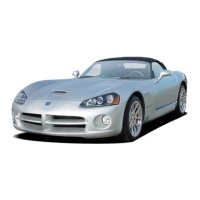
Do you have a question about the Dodge Viper SRT-10 and is the answer not in the manual?
| Brand | Dodge |
|---|---|
| Model | Viper SRT-10 |
| Category | Automobile |
| Language | English |
Welcomes the owner and introduces the vehicle's features.
Identifies key controls and features within the driver's immediate area.
Details various controls like gauges, start button, climate control, and transmission.
Explains the dashboard's instrument cluster and warning lights.
Describes speedometer, tachometer, indicators, and odometer messages.
Explains how to use the key fob for locking, unlocking, and the panic alarm.
Details manual door lock operation and how to arm/disarm the theft alarm system.
Covers the engine start button operation and the electronic immobilization system.
Emphasizes seat belt use and requirements for child restraint systems.
Provides instructions for installing child restraints using tether anchors and seat belts.
Details manual adjustments for seat position and recline.
Explains how to adjust the tilt steering column and power-adjustable pedals.
Covers adjustable foot rest and programmable key fob features like unlock options.
Explains how to enable/disable horn chirp and flashing lights with remote lock.
Details operation of turn signals, headlights, fog lights, and dimmer.
Explains wiper/washer lever use and the 1-to-4 skip shift feature.
Describes the operation of manual climate controls and air recirculation.
Provides instructions for lowering and raising the convertible top.
Explains how to adjust windows to reduce wind buffeting.
Details controls and functions of the non-touch-screen radio.
Instructions on how to store and recall radio station presets.
Covers radio modes, seeking, tuning, and clock setting for the navigation radio.
Explains setting daylight savings, time zones, and programming new destinations.
Details programming destinations by address, using the address book, map, and volume.
Describes the location and limitations of the vehicle's 12-volt power outlets.
Introduces the Viper ACR's fusion of street and racing technology.
Explains the ACR's aerodynamics and their effect on grip.
Details the front splitter's design, features, and necessary precautions.
Describes splitter components and maintenance for rub strips and inserts.
Covers the installation of the track extension and the function of the rear wing.
Explains wing stanchion adjustment and the properties of carbon fiber components.
Details the Viper ACR's two-piece brake rotors and their benefits.
Provides an alternative procedure for breaking in brake pads and rotors.
Covers brake caliper care and details about Pilot Sport Cup tires.
Introduces the adjustable coil-over racing dampers and their tuning.
Details damper components and the process for adjusting ride height.
Explains ride height adjustment sensitivity and recommended street setup.
Guides on adjusting the compression damping of the vehicle's dampers.
Details rebound adjustment and recommended track setups.
Covers track setups, tuning notes, and maintenance for performance components.
Describes the optional Hard Core Package and its weight-saving features.
Provides a template for recording tuning adjustments and track data.
Outlines warranty limitations for ACR components, especially regarding racing.
Acknowledgment form for the customer regarding package features and warranty.
Provides towing contact info and explains TPMS and engine temp warning lights.
Explains brake, MIL, charging system, and oil pressure warning lights.
Covers ABS, ETC, airbag warning lights and procedures for engine overheating.
Details the steps and precautions for using the TIREFIT tire repair kit.
Provides instructions and warnings for jump-starting the vehicle.
Advises on proper towing equipment and methods.
Offers guidance on how to free a stuck vehicle using a rocking motion.
Explains the purpose and data recorded by the Event Data Recorder.
Details the procedure for opening, propping, and closing the vehicle's hood.
Identifies key components and fluid reservoirs in the engine compartment.
Lists required fluids, lubricants, and their respective capacities.
Outlines recommended maintenance tasks based on mileage or time intervals.
Provides a template for recording vehicle maintenance history.
Illustrates the Power Distribution Center and lists fuse assignments.
Emphasizes checking and maintaining proper tire inflation pressures.
Provides guidance on cleaning wheels and replacing exterior bulbs.
Offers recommendations for storing the vehicle for extended periods.
Provides contact information for customer centers and how to order manuals.
Explains how to report safety defects and tire warranty details.
Discusses lift kit safety, tire inspection, and tire service life.
Highlights available MOPAR accessories for customizing the Dodge Viper.











